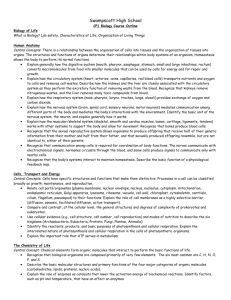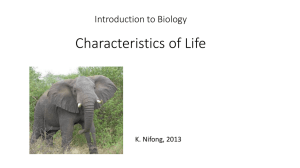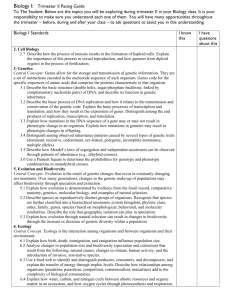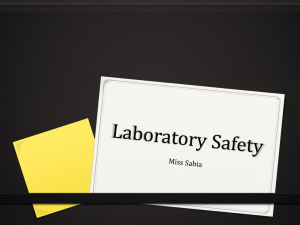Subject Assessments: Biology (5235) Test at a Glance
advertisement
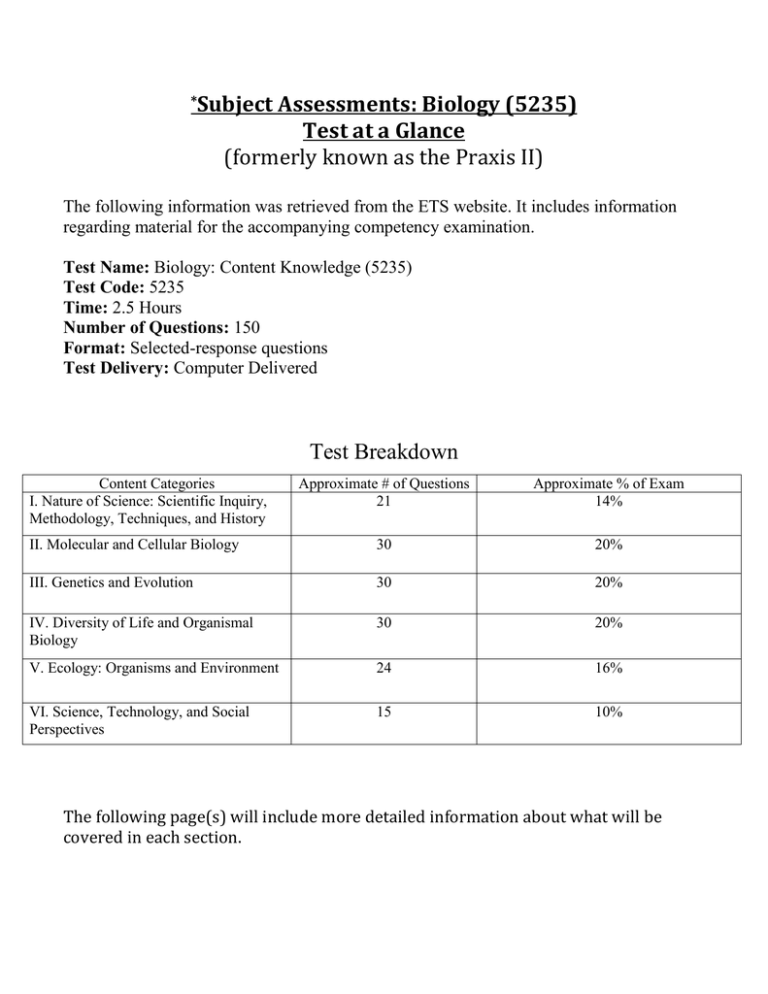
*Subject Assessments: Biology (5235) Test at a Glance (formerly known as the Praxis II) The following information was retrieved from the ETS website. It includes information regarding material for the accompanying competency examination. Test Name: Biology: Content Knowledge (5235) Test Code: 5235 Time: 2.5 Hours Number of Questions: 150 Format: Selected-response questions Test Delivery: Computer Delivered IV III Test Breakdown Content Categories I. Nature of Science: Scientific Inquiry, Methodology, Techniques, and History Approximate # of Questions 21 Approximate % of Exam 14% II. Molecular and Cellular Biology 30 20% III. Genetics and Evolution 30 20% IV. Diversity of Life and Organismal Biology 30 20% V. Ecology: Organisms and Environment 24 16% VI. Science, Technology, and Social Perspectives 15 10% The following page(s) will include more detailed information about what will be covered in each section. I. Nature of Science: Scientific Inquiry, Methodology, Techniques, and History A. Processes involved in scientific inquiry 1. Making observations (e.g., quantitative versus qualitative) 2. Formulating and testing hypotheses 3. Identifying experimental variables and controls 4. Drawing scientific conclusions (e.g., proof versus support) 5. Using scientific sources and communicating findings appropriately B. Science involves many disciplines 1.Chemical nature of biology 2. Mathematics in biology (e.g., statistics, proportions) 3. Physical laws and principles governing biological systems C. Differences among facts, hypotheses, theories, and laws 1.Testable nature of hypotheses 2. Formulation of theories based on accumulated data 3. Durability of laws D. Scientific ideas change over time; contributions made by major historical figures 1.Cell theory and germ theory (e.g., Hooke, Pasteur) 2. Heredity, evolution, and ecology (e.g., Mendel, Darwin) 3. Structure and nature of genetic material (e.g., Hershey and Chase, Franklin, Watson and Crick) 4. Classification of organisms (e.g., Linnaeus, Woese) E. Appropriate use of scientific measurement and notation systems 1. Precision versus accuracy 2. Metric and SI units 3. Unit conversions 4. Scientific notation and significant figures 5. Linear versus logarithmic scales (e.g., pH) F. Read and interpret data represented in tables, graphs, and charts 1. Identify patterns and trends in data 2. Choose appropriate types of graphs or charts 3. Error analysis 4. Draw conclusions and make predictions G. Construct and use scientific models to explain complex phenomena 1.Limitations of models 2. Select models for a given purpose 3. Physical (e.g., anatomical models), conceptual (e.g., fluid mosaic model), graphical and/or mathematical models (e.g., population growth models, global climate change) H. Procedures involved in the safe preparation, storage, use, and disposal of laboratory and field materials 1. Molarity and percent solutions 2. Acid and base solutions 3. Flammable and/or caustic chemicals 4. Biological specimens and waste I. Appropriate and safe use and care of laboratory equipment 1. Optical equipment (e.g., microscopes, spectrophotometers, UV light sources) 2. Separation equipment (e.g., gel electrophoresis, chromatography, centrifuges) 3. Measurement, mixing, and heating equipment (e.g., balances, stirrers, burners) 4. Sterilization equipment (e.g., autoclave, ovens) J. Safety and emergency procedures for science classrooms and laboratories 1.Use of material safety data sheets (MSDS) 2. Use of personal safety equipment: (e.g., gloves, goggles, labcoats) 3. Use of laboratory safety equipment (e.g., fire extinguishers, eye wash stations, emergency showers) II. Molecular and Cellular Biology A. Chemical structures and properties of biologically important molecules 1. Atomic structure 2. Organic versus inorganic molecules 3. Chemical bonding (e.g., hydrogen, covalent) 4. Molecular structure (e.g., carbon dioxide, ATP) 5. Water properties (e.g., cohesion, high specific heat) 6. Macromolecules (e.g., carbohydrates, nucleic acids, proteins, lipids) B. Biological processes are dependent on chemical principles 1. Chemical and physical gradients (e.g., osmosis, diffusion, temperature) 2. Thermodynamics 3. Anabolic and catabolic reactions (e.g., hydrolysis) 4. Reduction-oxidation reactions C. Structure and function of enzymes and factors influencing their activity 1. Active site structure and substrate binding (e.g., induced fit, lock and key) 2. Reaction kinetics (e.g., effects of temperature, pH, and inhibitors) 3. Regulation (e.g., cooperative binding, feedback inhibition) D. Biochemical pathways and energy flow within an organism 1. Cellular locations of biochemical pathways 2. Photosynthesis (e.g., photosystems, electron transport, C3 and C4) 3. Cellular respiration (e.g., fermentation, Krebs cycle, electron transport) 4. Chemosynthesis (e.g., deep sea vent microorganisms) E. Major differences between prokaryotes and eukaryotes 1. Cell size 2. Membrane bound organelles 3. Cell walls (e.g., peptidoglycan, cellulose) 4. Chromosome structure (e.g., circular versus linear) F. Structure and function of cells and organelles 1. Plant cells versus animal cells 2. Cell membranes 3. Membrane-bound organelles (e.g., nucleus, chloroplast) and ribosomes 4. Cytoskeleton G. Cells maintain their internal environment and respond to external signals 1. Selective permeability 2. Active and passive transport 3. Water movement (e.g., osmolarity, water potential) 4. Cell surface proteins and cell communication 5. Exocytosis and endocytosis 6. Hormone action and feedback H. Cellular division, the cell cycle, and how they are regulated 1. Cell cycle stages (G1, S, G2, M) 2. Mitosis and meiosis (e.g., stages, functions, results) 3. Cytokinesis (e.g., cleavage furrow, cell plate) 4. Cell cycle checkpoints I. Structure and function of nucleic acids 1. Sugar-phosphate backbone 2. DNA versus RNA 3. Complementary base pairing 4. Chromosome structure (e.g., nucleosome, telomeres, linear versus circular) 5. DNA replication J. Processes involved in protein synthesis 1. RNA transcription 2. mRNA processing (e.g., poly A tail, splicing) 3. Translation (e.g., ribosome structure, tRNA) K. Regulation of gene expression 1. Promoters 2. Enhancers 3. Transcription factors 4. Operons 5. Environmental influences (e.g., epigenetics) L. Cells may undergo differentiation and specialization 1. Differential gene expression 2. Stem cells (e.g., sources, developmental potential) M. Nature of mutations 1. Cause of mutations (e.g., recombination, translocation, mutagens) 2. Types of mutations (e.g., point mutations, deletions, inversion) 3. Somatic versus germ-line mutations N. Use of basic laboratory techniques to study biological processes 1. Gel electrophoresis 2. Microscopy 3. Spectrophotometry O. Use and applications of DNA technologies and genetic engineering 1. DNA sequencing and polymerase chain reaction (PCR) 2. Genome sequencing projects 3. Gene therapy 4. Cloning 5. Transgenic and genetically engineered cells Genetics and Evolution A. Mendel’s laws and predicting the probable outcome of given genetic crosses 1. Independent assortment 2. Law of segregation 3. Monohybrid and dihybrid crosses 4. Pedigree analysis B. Non-Mendelian inheritance 1. Linkage (e.g., recombination mapping) 2. Sex-linked inheritance 3. Multiple alleles, codominance, and incomplete dominance 4. Polygenic inheritance, epistasis, and pleiotropy 5. Organelle inheritance (e.g., mitochondrial inheritance) C. Chromosomal and genetic changes that lead to common human genetic disorders 1. Changes in chromosome numbers (e.g., Down syndrome) 2. Changes in chromosome structure (e.g., deletions, inversion, duplications) 3. Common genetic disorders (e.g., Sickle- cell anemia, TaySachs) D. Sources of genetic variation 1. Mutation 2. Crossing-over 3. Genetic exchange (e.g., transduction, transformation, conjugation) 4. Sexual reproduction (e.g., independent assortment) E. Mutations, gene flow, genetic drift, and nonrandom mating affect the gene pool of a population 1. Distribution and movement of alleles within populations 2. Distribution and movement of alleles between populations F. Principles and applications of Hardy- Weinberg equilibrium 1. Conditions of HW equilibrium 2. Calculating allele frequencies using the HW equation G. Mechanisms of evolution 1. Natural and artificial selection 2. Sexual selection 3. Genetic drift (e.g., bottleneck, founder effect) 4. Coevolution 5. Adaptive radiation H. Evidence that supports evolution 1. Molecular evidence (e.g., DNA sequence comparisons) 2. Structural and developmental evidence (e.g., homology, embryology) 3. Fossil record 4. Endosymbiosis 5. Convergent versus divergent evolution 6. Major evolutionary trends (e.g., cephalization, multicellularity) I. Genetic basis of speciation 1. Reproductive isolation (e.g., behavioral, postzygotic) 2. Types of speciation (e.g., allopatric, sympatric) J. Models of evolutionary rates 1. Gradualism 2. Punctuated equilibrium K. Scientific explanations for origin of life on Earth 1. Panspermia (e.g., asteroid seeding) 2. Abiotic synthesis of organic compounds (e.g., Urey-Miller experiment) 3. Biological influences on atmospheric composition (e.g., photosynthesis) 4. Development of self-replication (e.g., RNA world) L. Factors that lead to extinction of species 1. Lack of genetic diversity 2. Environmental pressures (e.g., climate and habitat change) 3. Human impacts 4. Interspecific competition IV. Diversity of Life and Organismal Biology A. Characteristics of living versus nonliving things 1. Cellular organization 2. Growth and reproduction 3. Regulation and responses to the environment 4. Obtain and use energy B. Historical and current biological classification systems of organisms 1. Kingdom system 2. Domain system C. Defining characteristics of viruses, bacteria, protists, fungi, plants, and animals 1. Structure (e.g., capsid, cell wall, organelles) 2. Organization (e.g., prokaryote, multicellular) 3. Modes of nutrition (e.g., heterotroph, autotroph) 4. Reproduction/replication (e.g., viral replication, binary fission, budding) D. Characteristics of the major animal phyla 1. Body plans (e.g., radial versus bilateral symmetry) 2. Body cavities (e.g., coelomates, pseudocoelomates, acoelomates) 3. Modes of reproduction 4. Modes of temperature regulation (e.g., endotherm, ectotherm) E. Organizational hierarchy of multicellular organisms 1. Cells 2. Tissues 3. Organs 4. Organ systems F. Anatomy and physiology of major organ systems in animals 1. Cardiovascular and respiratory 2. Reproductive 3. Digestive and excretory 4. Nervous and endocrine 5. Immune G. Maintenance of homeostasis in organisms 1. Role of structural components (e.g., kidney, hypothalamus) 2. Feedback mechanisms 3. Role of hormones (e.g., antidiuretic hormone (ADH), insulin) 4. Role of behaviors (e.g., diurnal, nocturnal, basking) H. Reproduction, development, and growth in animals 1. Gamete formation 2. Fertilization 3. Embryonic development 4. Growth, development, and aging I. Characteristics of major plant divisions 1. Vascular versus nonvascular plants 2. Flowering versus nonflowering plants 3. Monocot versus dicot J. Structure and function of major plant tissues and organs 1. Dermal 2. Vascular (xylem, phloem) 3. Ground (e.g., parenchyma, cortex) 4. Meristems 5. Flowers, stems, leaves, and roots K. Plant life cycles and reproductive strategies 1. Alternation of generations (i.e., gametophyte, sporophyte) 2. Pollination strategies (e.g., wind, insect) 3. Seed dispersal L. Plants obtain and transport water and inorganic nutrients 1. Roots 2. Xylem transport 3. Control (e.g., stomata) M. Plants transport and store products of photosynthesis 1. Products (e.g., simple and complex carbohydrates) 2. Phloem transport 3. Storage molecules (e.g., starch, cellulose) 4. Storage structures (e.g., plastids, vacuoles, tuber) Ecology: Organisms and Environments A. Hierarchical structure of the biosphere 1. Populations 2. Communities 3. Ecosystems 4. Biomes B. Biotic and abiotic components of an ecosystem influence population size 1. Resource availability and abiotic factors (e.g., nutrients and temperature) 2. Habitat and niche 3. Competition and predation C. Models of population growth 1. Exponential growth 2. Logistic growth (e.g., carrying capacity) D. Relationship between reproductive strategies and mortality rates 1. Sexual versus asexual reproduction 2. Parental investment 3. Numbers of offspring produced versus numbers that survive E. Relationships within and between species 1. Symbiosis (e.g., parasitism, commensalism, mutualism) 2. Predation 3. Competition and territoriality 4. Altruistic behaviors F. Changes occur during ecological succession 1. Primary versus secondary succession 2. Biomass, diversity, productivity, and habitat changes during succession G. Types and characteristics of biomes 1. Aquatic (e.g., stream, estuary, coral reef ) 2. Terrestrial (e.g., desert, grassland, tropical rain forest) H. Energy flow in the environment 1. Trophic levels (e.g., pyramids of biomass, pyramids of energy) 2. Food webs I. Biogeochemical cycles 1. Water cycle 2. Carbon cycle 3. Nitrogen cycle 4. Phosphorus cycle J. Effects of natural disturbances on biodiversity and ecosystems 1. Temporal and spatial disturbances (e.g., climate, fire, disease) 2. Fragmentation of ecosystems 3. Natural ecosystem recovery K. Humans affect ecological systems and biodiversity 1. Pollution (e.g., greenhouse gases, acid precipitation) 2. Habitat destruction (e.g., deforestation) 3. Introduced species (e.g., non-native, reintroduced) 4. Remediation (e.g., reforestation, mine reclamation) L. Connections among ecosystems on a local and global scale 1. Natural flow of material between ecosystems 2. Transport of materials by humans 3. Movement of organisms (e.g., migration) VI. Science, Technology, and Social Perspectives A. Impact of science and technology on the environment 1. Pollution and pollution mitigation (e.g., burning fossil fuels, green building, environmental cleanup) 2. Resource management (e.g., waste management, recycling) 3. Conservation (e.g., habitat protection, habitat restoration, species protection) 4. Non-point sources of pollution (e.g., lawn fertilizers) B. Impact of human activity and natural phenomena on society 1. Consequences (e.g., economic, social) 2. Disaster management (e.g., hurricane relief and cleanup) 3. Global warming, sea levels, flooding 4. Epidemiology (e.g., malaria, influenza) 5. Agriculture and soil erosion 6. Estuary and wetland degradation 7. Water management 8. Production, use, and disposal of consumer products (e.g., plastics) C. Societal impacts associated with the management of natural resources 1. Habitat preservation (e.g., Endangered Species Act, National Parks) 2. Extraction of mineral and energy resources (e.g., mining, drilling) 3. Agriculture, forestry, wildlife, and fisheries practices 4. Renewable and/or sustainable use of resources D. Ethical and societal issues arising from the use of science and technology 1. Ethical research concerns (e.g., stem cells, toxic chemicals) 2. Ethical use of technology (e.g., genetically modified organisms, cloning) 3. Societal concerns (e.g., security of genetic information, equal access to medical treatment) *According to new directives from PDE, any certification can be added by completing the Subject Assessment exam in that area. This directive does not apply to Special Education, Health and Physical Education, and Cooperative Education certificates.


